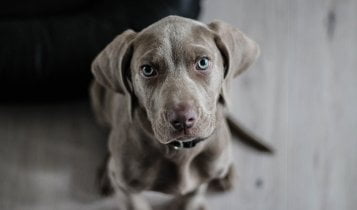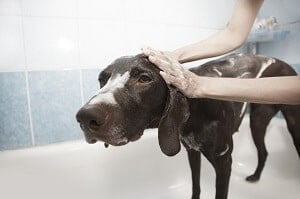Just like humans, dogs exhibit distinct signs and symptoms when they grow older.
The most common signs are deteriorating hearing and sight, inability to learn and recall, and lack of overall awareness.
Other vital functions might include less bladder and bowel control, and weak limb motion.
Often these signs are very subtle, especially early on, and thus it might not become apparent to dog owners right away.
However, if you are aware and know what signs to look for, you can take proper care and provide necessary treatment and ultimately save your dog from experiencing discomfort.
Seven Significant signs of an Aging Dog
There are some significant signs and symptoms which are a strong indicator your dog is aging and could possibly require medical attention.
This is especially true if these symptoms are related to common dog diseases.
You must not ignore these signs as the risks posed to your pup’s health could worsen, lead to other health problems, or sometimes even result in death if left untreated.
If after reading the points below, you are uncertain how to assess your dog’s health, take them to the vet as soon as possible for professional suggestions.
We know vets can be a scary place for dogs and owners, but treatment and proper advice go a long way.
Let’s look at some of the prominent signs displayed by dogs when they age.
1. Hearing and seeing worsens:

One of the first and most observed symptoms in aging dogs are the gradual deterioration or total loss of sense organs.
Essential sense organs assist dogs and humans alike, and include the eyes, ears, nose, mouth, and skin.
Be observant, if your dog is slow to respond to noises, or unable to sight toys and treats as early as before, then consider getting a sensory check.
Small tests like calling your dog’s name from another room, ringing the doorbell, or playing fetch might give you a better idea in determining if their sensory capabilities are deteriorating.
Hearing and seeing are on the earliest signs of aging.
2. Anxiety

Aging dogs tend to develop anxiety and can be a result of the first symptoms.
With lower hearing and seeing ability, dogs can get startled easily when they finally pick up on the noise or detect motion.
Anxiety can lead to behavioral changes in their daily lives.
For example, they might stare at objects for a long time, trying to figure out the source of the noise or focus in on an object they perceived to have moved.
Your dog may also wander aimlessly for a long period of time, looking for the source.
Not all dogs exhibit the same behavior as a result from anxiety.
Some may begin to stay quieter and remain in the same room out of comfort.
Others might become more aggressive in an attempt to defend themselves from what they perceive to be unusual.
Anxiety also affects your dog’s social relationship with you as well as other family members and pets.
Some begin to pick favorites and lose interest in other people and pets to avoid interaction. Some pets become over-dependent and clingy due to anxiety.
These are a few of the signs caused by anxiety.
Anxiety is one of the more difficult symptoms to self-diagnose as these signs are often overlooked and complicated to understand.
We understand vets can be expensive, but if after observing your dog for some time and you are still unable to determine if your dog has developed anxiety, please consider seeking the opinion of a vet.
Early detection of anxiety can help to figure out an appropriate treatment and aim to relieve your dog of anxiety.
3. Get cold easily
Another significant change in an aging dog is the weakening of the body and immune system.
If you find your dog shivering and shaking, especially while outside in the cold or while near windows, consider getting your pup a coat or sweater.
Though dogs have their own natural fur coat, older dogs body temperature regulation might be slow to respond as circulation and blood flow becomes slower.
All individuals are different but typically smaller dogs exhibit this symptom.
Try warming up your friend or getting a heated bed.
Keep in mind, as your dog gets older, being cold and catching a cold are both common occurrences.
A weaker immune system leads to catching illnesses and infections easily.
If your dog looks miserable and is exhibiting cold symptoms, make sure a lot of rest, warmth, and easy to digest food is in order.
If the symptoms persist, consider a trip to the vet and see if prescription medicine is necessary.
4. React and move slower
As dogs age they become relatively slower and their reactions become sluggish.
Although the development of certain illnesses can be the root cause, most of the time, it’s just the aging of muscles and joints which prevent them from being their younger selves.
Again, this symptom might go hand in hand with the first sign of aging: hearing and vision loss.
General slowness to react might not be a major cause for concern but on your next checkup or visit to the vet, ask whether arthritis or thyroid problems are a possibility.
5. Gaining weight easily

Studies have observed that older dogs put on weight far more quickly compared to younger dogs.
There are multiple reasons which can explain this, and some are actually a result of the signs discussed above.
The weakening of the immune system, the slowing down of the metabolism process, and thyroid abnormalities are some of the potential reasons or causes that your dog might be putting on weight much faster than before.
Dogs who pack on excess weight become lazy, inactive and lose enthusiasm for physical activities.
The snowball effect can be worrisome here, as a negative feedback loop disincentivizes interaction.
Similar to humans, gaining weight can lead to behavioral issues and even depression. Take careful watch of your dog’s diet and daily activities.
6. Confused and forgetful
Another common sign displayed by dogs who are aging is confusion and forgetfulness, even for the usual daily routine.
One example is the inability to recall prior learned commands and cues.
Your dog might mix up sit and paw, or forget both altogether and stare back at you in confusion.
If you have a large tract of land and let your dog roam freely, be aware that getting lost and forgetting the way back home is a real possibility.
Although dogs have a much stronger sense of smell and direction, dogs are not exactly homing pigeons.
7. Needing extra attention and grooming

When dogs age, they can become very needy – both physically and emotionally.
Do not be surprised to find your dog following you around the house, calling or whining for you if you are in another room, and looking for a quick head or back rub.
This exhibition of attention seeking is a classic sign of aging.
Do pay extra attention to your dogs coat, teeth, gums, nostrils, and eyes.
Shedding might occur more frequently, bad breathe might develop, and crusty eyes might be more common than before.
A few extra minutes of your day with your older pup will mean the world to them.
This is a quick overview of the common signs and symptoms of aging dogs.
We hope you find the article helpful. As always, please share any thoughts and questions down below in the comment section. Thank you for reading!
